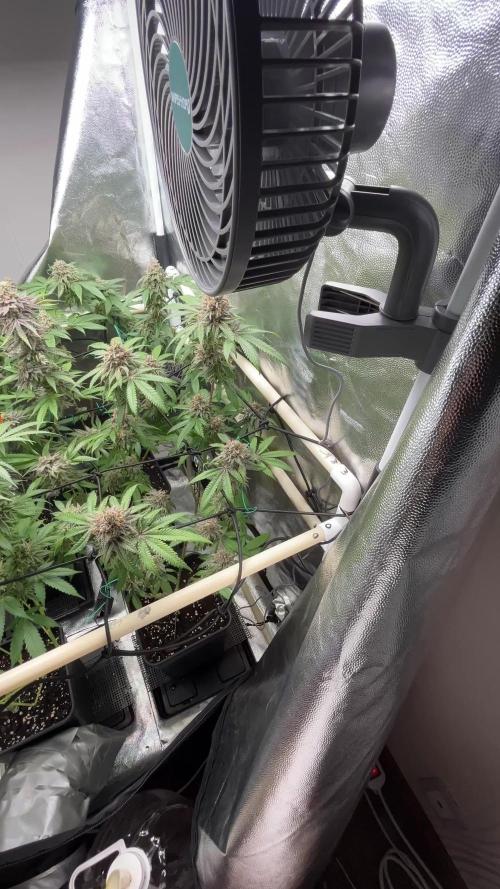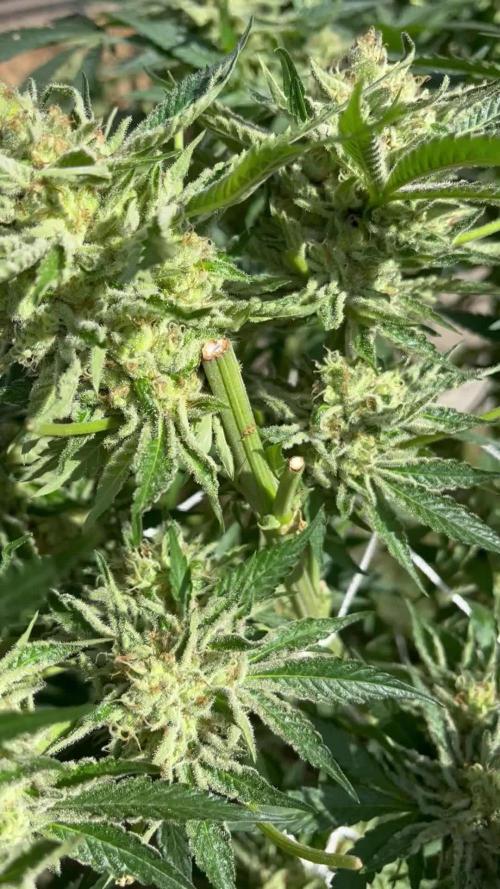The Grow Awards 2026 🏆 































Likes
Comments
Share


@Houdini
Follow
Now she taking the whole greenhouse, Nutriment added twice a week
Water ph: unknow💦
Likes
32
Share


@BigDaddyK
Follow
fighting the thrips, they dont make a difference to the flowers , it just looks shit on the leaves, also you have to keep a very close eye on the ph.
Tall one is having a big munch on the nutrients
I change the reservoir every monday 💦
Likes
4
Share


@GreenForMiles
Follow
This strain was a mystery from the beginning. I planted 6 plants and got 4 drastically different phenos. Surprisingly they all have similar aromas but visually they’re much different. She stretched a lot and needed two layers of the sCrog net. One plant had 2 random seeds so I’ll probably be planting her again. Next time I’ll use a low stress method to see her at her full potential!
Likes
31
Share


@RFarm21
Follow
Hello growmies!
Foi alimentada dia 12 dezembro , misturada com 2l de água. Runoff pH: 6.2/ EC: 2.40
Além da deficiência de nitrogênio aparenta ter também uma deficiência de magnésio.
Likes
8
Share


@I_roll_my_own_420
Follow
buds are getting heavy. around 32-35 more days of flower expected.
Likes
12
Share


@Jardin33ro
Follow
Buenas gente! Esta semana se nota tremendamente el engorde de los calices, y algunos comienzan a cerrar de a poco! Una maravilla en cuanto a terpenos!! Tuve el honor de cortar unas flores para analizar en la expocannabis uruguay, les dejo un video con esa info de una de los 4 fenos. Empezamos a lavarr, primer uso del flawless asi que nos ponemos con el lavaditooo!! Venimos bien de bien. Saludos Jardin33ro 🇺🇾
Likes
16
Share


@Northern_Ent
Follow
Sep 27: still lots of buds remaining and did a big defoliation to expose them to sunlight. Very nice and the hash resin looks terrific. Awesome.
Likes
58
Share


@MadeInGermany
Follow
Hey everyone :-).
On the 63rd day of flowering after the time change to 12/12 the harvest was carried out after 48 hours of darkness 😍.
I love this black pheno 👍.
After the harvest, everything was laid out on nets where it is allowed to dry at 62% for the next 8-14 days before fermenting with 62% boveda packs in glasses 😍.
The entire system was cleaned immediately for the next round. I wish you all a lot of fun with the interim update and we'll see you at the end 😅👍.
Stay healthy and let it grow 🍀
You can buy this Strain at :
www.Zamnesia.com
☝️🏼☝️🏼☝️🏼☝️🏼☝️🏼☝️🏼
Strain
Gelato clone from mother (Zamnesia )
☝️
Genetics: Wedding Cake x Gelato x Gelato 33
👍
Vega lamp: 2 x Todogrow LED CXB3590 COB 55 W
1 x Sanlight S2W 62 W
💡
Flower lamp : 2 x Todogrow LED CXB3590 COB 55 W
1 x Sanlight S2W 62 W
💡 ☝️
Grow Aero System : Growtool 0.8
☝️
Fertilizer:
Canna Aqua Vega A + B , Canna Aqua Flores A + B , Rizotonic, Cannazym, CANNA Boost, Pk 13/14, Canna Cal / Mag, Canna Ph - Grow, Canna Ph-Bloom
☝️🌱
Water:
Osmosis water mixed with normal water (24 hours stale that the chlorine evaporates) to 0.2 EG. Add Cal / Mag to 0.4 Ec Ph with ph- to 5.2 - 5.8
💦 💧
Processing
Likes
14
Share


@DUBDOLLASIGN100
Follow
I'm amped up about these 6 Gotti Ogs and these 2 Downtown Finest Og strains, there growing fast eating a lot and the weather is great in Cali. These indoor veg and outdoor flower is really working well for me. I'm using Flora nova bloom and there booming
Likes
27
Share


@adam_pawloski87
Follow
First off I just want to say for some reason it’s not letting me change the right temperatures on my diaries ! Each time when I put it in they stay at 50. My day air stays 75 degrees an , night degrees is 70 !
Today is day 58 for all these ladies! This week has been really great ! Girls really progressed a lot , especially for one the Forbiddin Runtz, looks like is gonna finish up in a week or 2 ! Other then that they are coming along well! Keep those eyes peeled for next week! Cheers😶🌫️💨💨💨💨
Likes
15
Share


@AloeLover
Follow
She's in a small tent, do you think I should flip the switch? Every time I take some bottom leaves off more come back LOL. What do you think?😎
Processing
Likes
10
Share


@Barcelona_Farmers710
Follow
Entramos en semana 4 de flora con un calor extremo con el Lec... a la espera de renovar equipo a led pero tendremos que acabar con Lec está tirada farmers, a pesar de todo tiene bastante resina y huele bastante bien sobre todo la Sweet Skitllez!🍁
Likes
7
Share


@Eponymus29
Follow
Transplanted her into a 3 gal air pot, added some mycorrhizae to the soil and watered her with pH'd water 6.0...
Likes
2
Share


@Bluemels
Follow
Tag 63: Die Green Gelato entwickelt sich wie im Bilderbuch. Sie hat sich nicht zu sehr gestreckt. Ich muss wohl kaum was weg nehmen außer unten ein paar helle Blätter 😁
Tag 67: Hatte heute die Erleuchtung! Ich gieße ausschließlich mit Britta gefiltert Wasser, was wohl auch schon das ein oder andere Mal zu Kalzium und Magnesium Mangel geführt hat. Was sich aber erst bei Cookies Gelato (grow 32) so deutlich gezeigt hat. Ich stelle nun langsam auf Leitungswasser um.
Processing
Likes
17
Share


@SuperGlue
Follow
Begining of the week two from germination , + 8 cm.
Day 8 just water ph 6
Day 9 rest
Day 10 rest , + 2 cm
Day 11 watering
Day 12 rest
Day 13 FOL fish mix , cal/mag extra
Day 14 rest
Likes
31
Share


@Tweak
Follow
Lots of new growth this week, looks like the screen is about 50% full, I’m thinking in the next week or two I’ll get to 12/12. In the mean time I’m adding an extra hour of darkness every few days to make her transition to flower smooth and stress less for her.






















